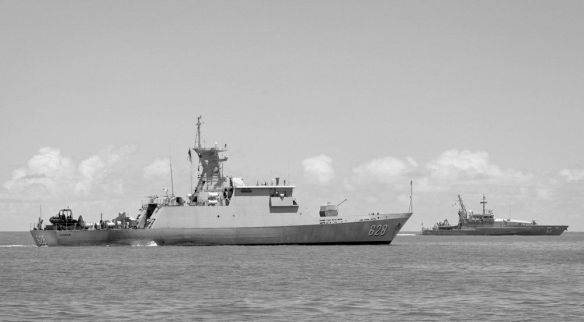The Indonesian Navy’s procurement is currently split between small numbers of ‘high-end’ vessels and larger numbers of less sophisticated patrol and missile craft. Typical of the latter is the lead KCR-60 missile-armed fast attack craft Samapri, seen here on exercises with the Royal Australian Navy’s Wollongong in March 2016. (Royal Australian Navy)
Two images of the first Indonesian ‘Sigma 10514’ frigate Raden Eddy Martadinata, being floated out from PT Pal’s dockyard in Surabaya in January 2016. Construction of two ships is currently underway and more could be ordered in what is probably the most important Indonesian surface warship construction programme. (Piet Sinke via Damen Schelde Naval Shipbuilding)
Indonesian naval procurement continues to be split between a small number of ‘high-end’ war-fighting vessels and large numbers of relatively unsophisticated patrol ships of various shapes and sizes for constabulary roles. 14 Further progress has been made in both areas over the last year. However, the long-term target of achieving a 274- strong fleet – including over a hundred combatants – by 2024 that was first announced in the Minimum Essential Forces modernisation programme initiated in 2009, looks set to be substantially scaled back to a little over 150 units. In effect, new deliveries are just about matching the pace of withdrawals.
The most costly front-line programme in progress is for the construction of three new Type 209 submarines to an improved version of South Korea’s Chang Bogo design. The first of these, Nagabanda, was rolled-out in March 2016 by DSME and should be delivered on schedule during 2017. DSME is also building a second member of the class, Trisula. Construction then scheduled to switch to PT PAL in Surabaya where a new facility should start work on the final boat from October 2016. The selection of the Type 209 design makes sense given Indonesia already has substantial experience of operating a pair of similar boats since the early 1980s. However, it appears that other designs are also being examined for further construction that is ultimately intended to extend the underwater flotilla to between ten and twelve submarines. These include Russia’s ‘Kilo’ class and the French DCNS ‘Scorpène’ design.
Meanwhile, construction of surface combatants is being assisted by a long-standing alliance with the Dutch Damen group, which delivered four ‘Sigma 9113’ class corvettes between 2007 and 2009. Assembly of a follow-on class of larger ‘Sigma 10514’ light frigates has transferred to PT PAL, who are currently building two units. The first of these, Martadinata, was launched on 18 January 2016. It seems that it is currently hoped to build at least six of the class to replace the elderly Van Speijk class frigates, which are reported to fall due for decommissioning from 2017 onwards.
Other surface assets include the three Bung Tomo class corvettes originally ordered by Brunei from BAE Systems and delivered in 2014 and the three older Fatahillah vessels built in the Netherlands in the late 1970s. The first of these has been completing a mid-life upgrade led by Ultra Electronics but it is not known whether this work will extend to the two other ships. Fifteen Project 1331 ‘Parchim 1’ are also still in service, although one – Pati Ununs – was partly sunk in a grounding incident in May 2016 and may not be repaired.
Turning to smaller vessels, recent years have seen an expansion in orders of fast attack craft based on the KCR-40, KCR-60 and KCR-63 designs. However, reports suggest that production of the KCR-63 Klewang class trimarans will not progress beyond a single vessel and that the SAAB combat suite envisaged for the boat will no longer be fitted. However, a fourth KCR-63 vessel has been ordered to supplement the three already in commission, whist the KCR-40 hull has been selected as the basis for a more lightly-armed patrol vessel variant.
Whilst current focus is on indigenous construction, foreign yards have been contracted for specialised ships. For example, the first of two Rigel class hydrographic ships built by OCEA in France arrived in Indonesia in May 2015. Her sister, Spica – commissioned in October of the same year – followed in December. A new sail training ship is also under construction at the Freire Shipyard in Spain for delivery in 2017.
